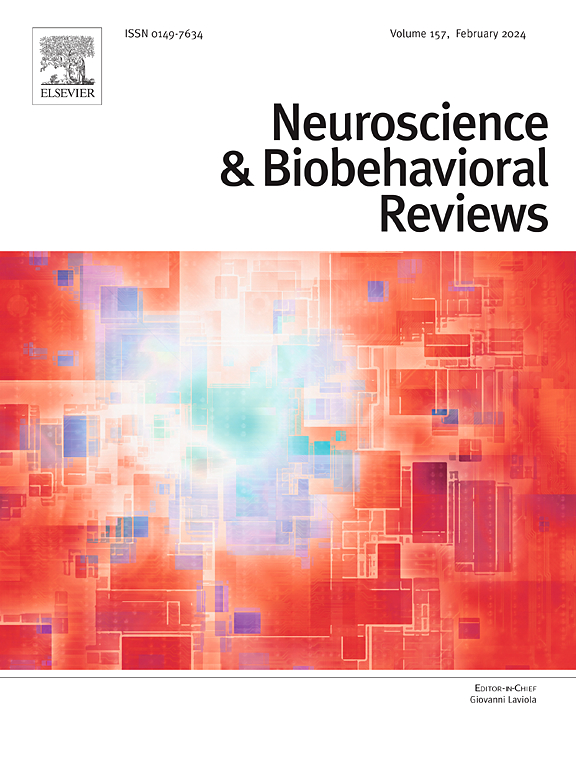Serotonin-dopamine interactions in psychostimulant-induced gene regulation: SSRI antidepressants potentiate gene regulation by methylphenidate (Ritalin) in the striatum and enhance behavioral profile indicative of addiction liability in rodents
IF 7.9
1区 医学
Q1 BEHAVIORAL SCIENCES
引用次数: 0
Abstract
Selective serotonin reuptake inhibitor (SSRI) antidepressants are used in combination with the medical psychostimulant methylphenidate (Ritalin), a dopamine reuptake inhibitor, in a variety of treatments in children and adults. Unintended co-exposure to these medications also occurs in patients on SSRIs who abuse methylphenidate as a “cognitive enhancer” or recreational drug. This review summarizes a series of studies on the neurobehavioral effects of such drug combinations, administered either orally (mimicking clinical doses) or intraperitoneally (abuse doses), in adolescent rats. Prototypical SSRIs such as fluoxetine (Prozac) given together with methylphenidate produce various behavioral changes, including facilitated acquisition of cocaine self-administration and increased reinstatement of cocaine seeking (model for relapse). Consistent with these behavioral effects, prototypical (but not novel atypical) SSRIs potentiate abuse/addiction-associated gene regulation by methylphenidate in dopamine target areas such as the striatum. Studies investigating the mechanisms underlying these effects revealed that 5-HT1A and 5-HT1B serotonin receptors inhibit and facilitate, respectively, such gene regulation. These findings indicate that combining methylphenidate with prototypical SSRIs may increase the abuse/addiction liability for psychostimulants, and that 5-HT1A and 5-HT1B receptors may serve as pharmacological targets to alleviate this risk.
5 -羟色胺-多巴胺在精神兴奋剂诱导的基因调控中的相互作用:SSRI抗抑郁药增强纹状体中哌醋甲酯(利他林)的基因调控,并增强啮齿动物成瘾倾向的行为特征
选择性血清素再摄取抑制剂(SSRI)抗抑郁药与医学精神兴奋剂哌醋甲酯(利他林)(一种多巴胺再摄取抑制剂)联合使用,用于儿童和成人的各种治疗。在服用SSRIs的患者中,滥用哌甲酯作为“认知增强剂”或娱乐性药物也会意外地同时暴露于这些药物。这篇综述总结了一系列关于这些药物组合的神经行为效应的研究,无论是口服(模拟临床剂量)还是腹腔注射(滥用剂量),在青春期大鼠中。典型的ssri类药物,如氟西汀(百忧解)与哌醋甲酯一起服用,会产生各种行为改变,包括促进可卡因的自我获取和增加可卡因寻求的恢复(复发模型)。与这些行为效应一致的是,典型的(但不是新颖的非典型的)SSRIs增强了哌醋甲酯在多巴胺靶区(如纹状体)中的滥用/成瘾相关基因调控。研究发现,5-HT1A和5-HT1B血清素受体分别抑制和促进这种基因调控。这些发现表明,哌甲酯与典型SSRIs联合使用可能会增加精神兴奋剂的滥用/成瘾倾向,而5-HT1A和5-HT1B受体可能是减轻这种风险的药理学靶点。
本文章由计算机程序翻译,如有差异,请以英文原文为准。
求助全文
约1分钟内获得全文
求助全文
来源期刊
CiteScore
14.20
自引率
3.70%
发文量
466
审稿时长
6 months
期刊介绍:
The official journal of the International Behavioral Neuroscience Society publishes original and significant review articles that explore the intersection between neuroscience and the study of psychological processes and behavior. The journal also welcomes articles that primarily focus on psychological processes and behavior, as long as they have relevance to one or more areas of neuroscience.

 求助内容:
求助内容: 应助结果提醒方式:
应助结果提醒方式:


